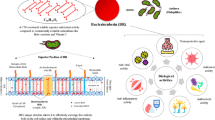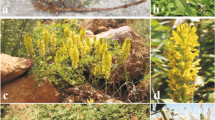Abstract
Schisandra chinensis (Turcz.) Baill (S. chinensis), an edible traditional medicine herb, has a strong constitution, which extract has good antibacterial activity. The study investigated its antibacterial properties on E. coli, to find a candidate for the development as new preservative. In vitro antibacterial assay showed that S. chinensis extract (SCE) effectively inhibited the growth of test bacteria with MBC of 18 mg/mL. In model cosmetic system of O/W emulsions, SCE possessed a great antibacterial capacity. The growth curves of E. coli treated with SCE exhibited an extended lag phase and restricted log phase. Scanning electron microscopy showed that the treated E. coli cells exhibited wrinkled and withered surfaces, and disappearing outmost layer, suggesting S. chinensis extract can damage S. aureus cell member and wall, in addition, the leakage of periplasm enzyme AKPase and the increased activities of Na+/K+-ATPase and Ca++-ATPase in cell membrane were also consistent with the microscopy results. Moreover, the S. chinensis extract can decrease the activities of dehydrogenase and total ATPase and the content of intracellular proteins, and bind with S. aureus DNA by electrostatic and groove binding. The results indicated that SCE might be a candidate cosmetic preservative for its good antibacterial activity and multiple targets on E. coli.






Similar content being viewed by others
References
Szopa A, Ekiert R, Ekiert H (2017) Current knowledge of Schisandra chinensis (Turcz.) Baill. (Chinese magnolia vine) as a medicinal plant species: a review on the bioactive components, pharmacological properties, analytical and biotechnological studies. Phytochem Rev 16(2):195–218
Liu Z, Guo F, Wang Y, Li C, Zhang X, Li H, Diao L, Gu J, Wang W, Li D (2016) BATMAN-TCM: a bioinformatics analysis tool for molecular mechANism of traditional chinese medicine. Sci Rep 6:21146
Kang YS, Han MH, Hong SH, Park C, Hwang HJ, Kim BW, Kyoung KH, Choi YW, Kim CM, Choi YH (2014) Anti-inflammatory effects of Schisandra chinensis (Turcz.) Baill fruit through the inactivation of nuclear factor-κB and mitogen-activated protein kinases signaling pathways in lipopolysaccharide-stimulated murine macrophages. J Cancer Prev 19(4):279–287
Yue C, Chen J, Hou R, Liu J, Li X, Gao Z, Liu C, Wang D, Yu L, Li H (2015) Effects of selenylation modification on antioxidative activities of Schisandra chinensis polysaccharide. PLoS ONE 10(7):e134363
He JL, Zhou ZW, Yin JJ, He CQ, Zhou SF, Yu Y (2014) Schisandra chinensis regulates drug metabolizing enzymes and drug transporters via activation of Nrf2-mediated signaling pathway. Drug Des Devel Ther 9:127–146
Xu L, Grandi N, Del VC, Mandas D, Corona A, Piano D, Esposito F, Parolin C, Tramontano E (2015) From the traditional Chinese medicine plant Schisandra chinensis new scaffolds effective on HIV-1 reverse transcriptase resistant to non-nucleoside inhibitors. J Microbiol 53(4):288–293
Song LY, Cui SM, Li T, Yang SR, Wang Q, He KK, Zheng YM, He CF (2018) Antibacterial effects of Schisandra chinensis extract on Staphylococcus aureus and its application in food (accepted). J Food Saf 5(38):e12503
Wang Q, Cui S, Zhou L, He K, Song L, Liang H (2018) Effect of cosmetic chemical preservatives on resident flora isolated from healthy facial skin. J Cosmet Dermatol 18(2):652–658
Nishihama Y, Yoshinaga J, Iida A, Konishi S, Imai H, Yoneyama M, Nakajima D, Shiraishi H (2016) Association between paraben exposure and menstrual cycle in female university students in Japan. Reprod Toxicol 63:107–113
Saatci C, Erdem Y, Bayramov R, Akalın H, Tascioglu N, Ozkul Y (2016) Effect of sodium benzoate on DNA breakage, micronucleus formation and mitotic index in peripheral blood of pregnant rats and their newborns. Biotechnol Biotec Eq 30(6):1179–1183
Lee SY, Kim KBWR, Lim SI, Ahn DH (2014) Antibacterial mechanism of Myagropsis myagroides extract on Listeria monocytogenes. Food Control 42(42):23–28
Fang B, Yu M, Zhang W, Wang F (2016) A new alternative to cosmetics preservation and the effect of the particle size of the emulsion droplets on preservation efficacy. Int J Cosmet Sci 38(5):496–503
Smaoui S, Hlima HB (2012) Effects of parabens and isothiazolinone on the microbiological quality of baby shampoo: the challenge test. Biocontrol Sci 17:135–142
Jaumot J, Gargallo R (2012) Experimental methods for studying the interactions between G-Quadruplex structures and ligands. Curr Pharm Des 18:1900–1916
Sarwar T, Rehman S, Husain M, Ishqi H, Tabish M (2015) Interaction of coumarin with calf thymus DNA: deciphering the mode of binding by in vitro studies. Int J BioMacromol 73:9–16
Opletal L, Krenková M, Havlícková P (2001) Phytotherapeutic aspects of diseases of the circulatory system 8 Chinese magnolia (Schisandra chinensis (Turcz.) Baill.): production of the drugs and their evaluation, therapeutic and dietary preparations. Ceská a Slovenská farmacie: casopis Ceské farmaceutické spolecnosti a Slovenské farmaceutické spolecnosti 50(5):219–224
Ryool, KY, Hwan, CI, Seog, SG, Seok, MB, Hye, PC, Mee, CY, Eok, KO, and Kyung, CY (2011). Composition useful as health functional food composition for preventing, improving and treating obesity, preferably growing obesity due to increased number of adipocytes, comprises mixed extract of Aronia and Schisandra chinensis.
Hyun, CY, Woo, JJ, Choieunok, Lee, KW, Ki, YK, Sung, GK, Kim, S, Hong, SH, and P, C (2018). Composition useful as quasi drug composition and food composition for preventing and treating arthritis including osteoarthritis and rheumatoid arthritis, comprises Schisandra chinensis extracted by freezing Schisandra, p. 1294732238.
Gottesman M, Simpson RT, Vallee BL (1969) Kinetic properties of cobalt alkaline phosphatase. Biochemistry 8:3776–3783
Huang Q, Zhou M, Ye Z (2001) Effect of amicarthiazol to the cell of Xanthomonas citri. J Nanjing Agric Univ 24(3):23–26
Fan L, Tong Q, Dong W, Yang G, Hou X, Xiong W, Shi C, Fang J, Wang WJOF (2014) Tissue distribution, excretion, and metabolic profile of dihydromyricetin, a flavonoid from vine tea (Ampelopsis grossedentata) after oral administration in rats. J Funct Foods 9(1):290–294
Shen S, Zhang T, Yuan Y, Lin S, Xu J, Ye H (2015) Effects of cinnamaldehyde on Escherichia coli and Staphylococcus aureus membrane. Food Control 47(47):196–202
Li YQ, Han Q, Feng JL, Tian WL, Mo HZ (2014) Antibacterial characteristics and mechanisms of ɛ-poly-lysine against Escherichia coli and Staphylococcus aureus. Food Control 43:22–27
Feng H, Ying Y, Yang G, Yu L (2010) Studies on antibacterial activity and antibacterial mechanism of a novel polysaccharide from Streptomyces virginia H03. Food Control 21(9):1257–1262
Acknowledgements
This work was financially supported by the National Natural Science Foundation of China (Grant No. 31401390).
Author information
Authors and Affiliations
Corresponding author
Additional information
Publisher's Note
Springer Nature remains neutral with regard to jurisdictional claims in published maps and institutional affiliations.
Rights and permissions
About this article
Cite this article
Cui, S.M., Li, T., Wang, Q. et al. Antibacterial Effects of Schisandra chinensis Extract on Escherichia coli and its Applications in Cosmetic. Curr Microbiol 77, 865–874 (2020). https://doi.org/10.1007/s00284-019-01813-6
Received:
Accepted:
Published:
Issue Date:
DOI: https://doi.org/10.1007/s00284-019-01813-6




